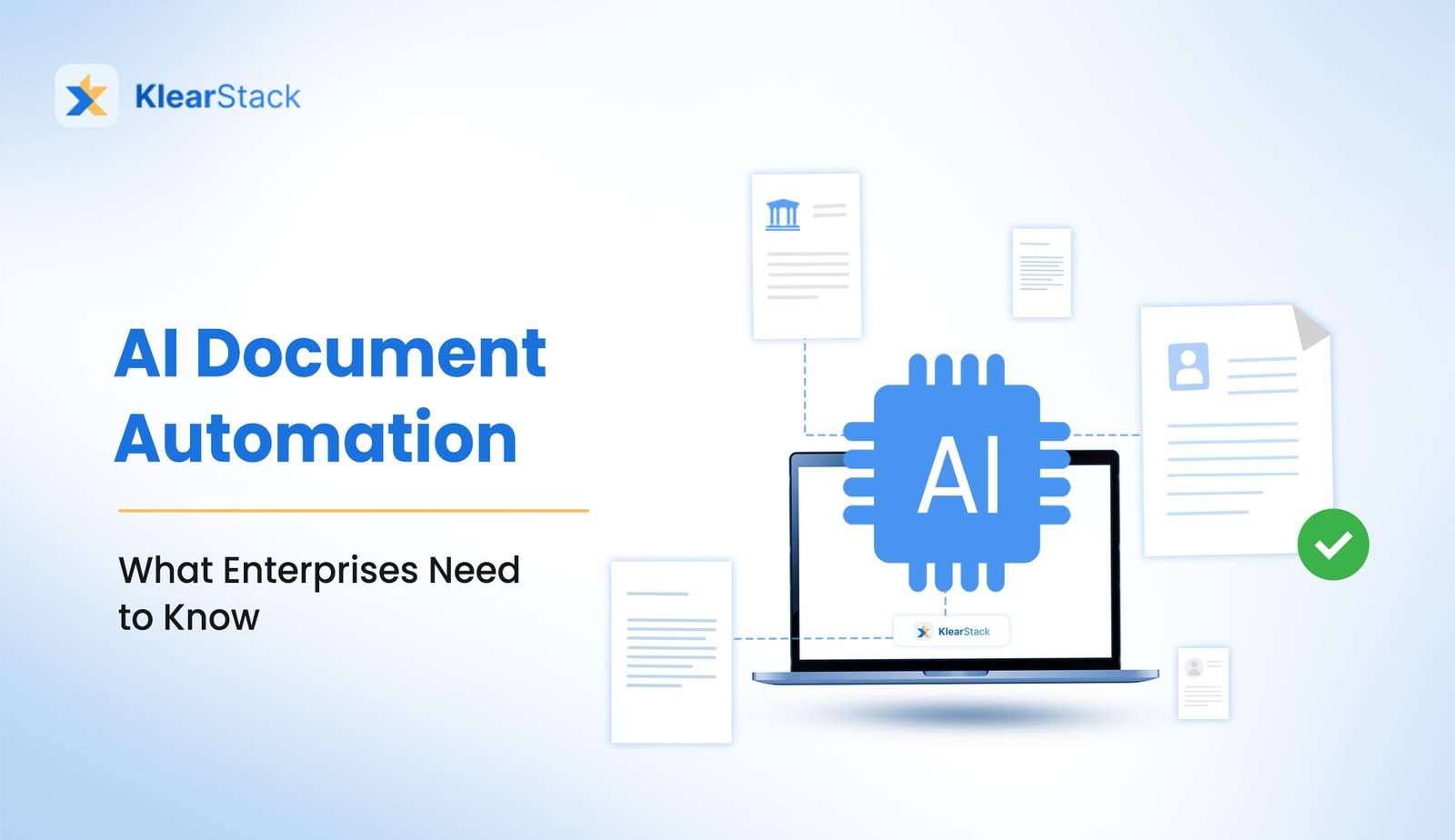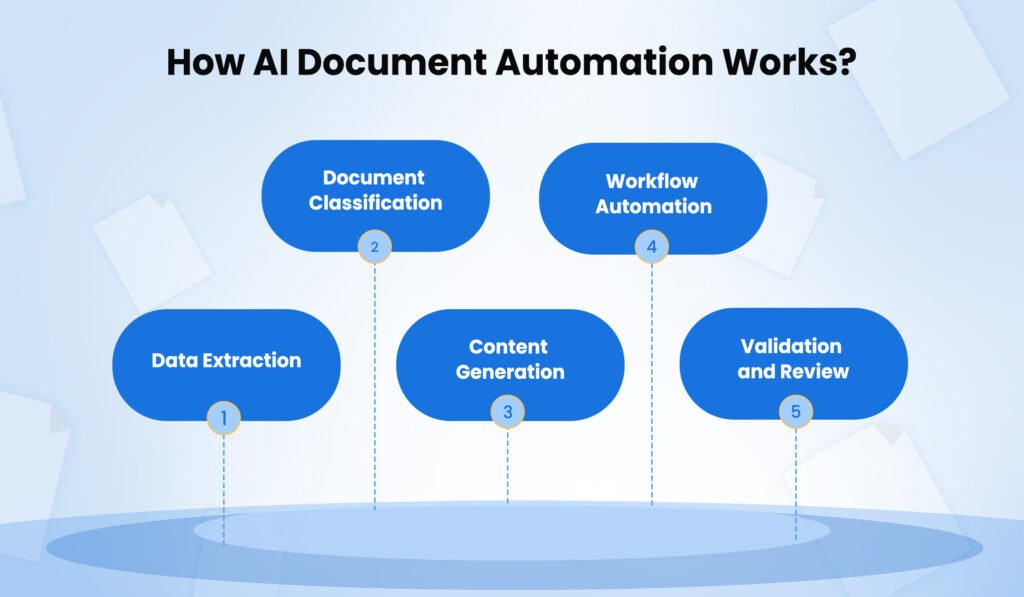AI Document Automation vs Traditional Processing: What Enterprises Need to Know in 2025

It may surprise you to find out that employees spend about 30% of their time maintaining and finding papers (International Data Corporation)
For enterprises still relying on manual document handling, whether it’s extracting data, processing invoices, or managing contracts, this translates into lost productivity, higher costs, and compliance risks.
AI-powered document automation changes the equation. Businesses may use artificial intelligence, machine learning, and natural language processing to transform unstructured documents into structured, usable data more quickly, smartly, and at scale.
In this article, we will go over what AI document automation is, how it works, its main capabilities, industry use cases, and why it beats traditional document processing,giving you a clear path to modernizing your workflows.
What is AI Document Automation?
AI document automation uses artificial intelligence to streamline and automate tasks related to documents, such as data extraction, content creation, classification, and workflow management.
It combines machine learning (ML) and natural language processing (NLP) to understand, process, and generate documents.
AI-powered automation can manage both organized and unstructured data, in contrast to traditional document processing, which primarily relies on employees.
This makes it possible for businesses to increase precision, save operating expenses, and quicken digital transformation projects in many divisions and sectors.
AI document automation generates intelligent workflows in addition to digitization. It transforms static data, including contracts, invoices, patient records, and employee files, into actionable insights that improve regulatory compliance and decision-making right away.
How AI Document Automation Works?

AI document automation turns managing documents manually into a more efficient digital procedure. It ensures accuracy, timeliness, and compliance by capturing, classifying, generating, and validating information using machine learning and natural language processing.
Usually, the procedure consists of five essential steps.
- Data Extraction: AI decodes text, handwriting, barcodes, and scanned images to retrieve both organized and unstructured data. This speeds up processing, removes errors from human entry, and gives businesses access to clean, usable data.
- Document Classification: AI automatically classifies documents according to their nature, including contracts, invoices, HR papers, and medical paperwork. Documents are arranged for compliance and quick retrieval through classification, which also guarantees accurate routing and minimizes processing delays.
- Content Generation: AI creates contracts, invoices, reports, and personnel records by filling templates with data that has been extracted. By doing this, teams can concentrate on higher-value work because it guarantees correctness and consistency and eliminates repetitive chores.
- Workflow Automation: Automated processes including notifications, approvals, and system changes are triggered by processed data. By integrating with enterprise systems, bottlenecks are lessened, smooth collaboration is guaranteed, and departmental digital workflows are accelerated.
- Validation and Review: AI automates validation procedures to guarantee regulatory compliance and data integrity. In order to maintain high levels of speed and ensure quality, human reviewers only step in for exceptions or errors.

(Source)
Key Capabilities and Applications of AI Document Automation
Here are some of the key applications of AI document automation
- Invoice Processing: From bills, AI extracts payment terms, item descriptions, and supplier information. This improves cash flow and financial accuracy by automating accounts payable operations, lowering errors, and guaranteeing quicker approvals.
- Contract Management: By identifying important phrases, commitments, and deadlines, AI simplifies the processing of contracts. It ensures uniformity across legal papers, streamlines contract review, quickens approvals, and reduces compliance risks.
- Customer Onboarding: AI collects and verifies necessary papers, including IDs, proofs, and forms, automatically. With quicker, error-free processing, this improves customer experience, speeds up onboarding, and decreases manual inspections.
- Compliance: AI checks and validates document data against internal standards, rules, or policies. It lowers audit risks, guarantees adherence to industry compliance standards, and fortifies governance through dependable, transparent procedures.
- Legal Operations: AI helps legal teams with the creation, evaluation, and administration of agreements, contracts, and case files. It improves accuracy, saves time on tedious duties, and frees up legal professionals to work on more significant projects.
| Still managing documents manually? Let AI take over faster, smarter, and error-free.Connect with our experts |
Benefits of AI Document Automation
Here are the Benefits of AI document management:
- Increased Efficiency: By automating tedious human processes, AI speeds up document processing. Businesses save quite a lot of time, optimize processes, and free up staff members to concentrate on higher-value tasks that drive innovation and expansion.
- Improved Accuracy: AI reduces human mistakes by reliably and accurately extracting data. By ensuring that papers are processed accurately the first time, the finance, legal, and operational teams may minimize rework, compliance concerns, and expensive errors.
- Cost Reduction: Automating workflows saves operating expenses by lowering human labor, paper-based processes, and error-related costs. Businesses scale document management without hiring more people while optimizing resources and increasing return on investment.
- Enhanced Customer Experience: Faster turnaround times for service inquiries, onboarding, and billing are made possible with AI. Real-time involvement, prompt responses, and more seamless interactions benefit partners and customers, enhancing long-term partnerships and confidence.
- Better Decision-Making: Business executives can gain deeper insights when they have access to fast, accurate, and structured data. Automation driven by AI facilitates data-driven planning, quicker reporting, and assured decision-making, all of which help businesses remain competitive in quickly changing markets.
AI Document Automation vs Traditional Document Processing
| Aspect | Traditional Document Processing | AI Document Automation |
| Speed | Relies on manual effort, causing delays and longer turnaround times. | Accelerates workflows, completing document-related tasks in minutes instead of hours or days. |
| Accuracy | Prone to human errors in data entry, classification, and validation. | Ensures precise data extraction and validation, reducing mistakes and compliance risks. |
| Scalability | Struggles to handle large document volumes effectively. | Scales effortlessly to process structured and unstructured data across industries. |
| Cost | High labor and operational expenses due to manual work. | Reduces costs by automating repetitive tasks and optimizing resources. |
| Intelligence | Limited to storage and retrieval without advanced insights. | Adds intelligence with workflow automation, content generation, and actionable insights. |
Common Industrial Use Cases for AI Document Automation
Read the practical use cases of how AI document automation can help various industries.
- Finance: Imagine closing your books with no paper trails to follow. Finance teams benefit from speedier approvals, precise reporting, and audit-related peace of mind thanks to AI’s automation of invoice processing, payment information extraction, and compliance record management.
- Legal: Hours are no longer needed to complete contracts. AI arranges case files, creates standard agreements, and evaluates provisions. Legal teams devote more time to strategy and client service and less time to monotonous duties.
- Healthcare: Treatment is frequently slowed down by patient records, insurance claims, and compliance paperwork. Medical personnel may concentrate on patient outcomes while maintaining accuracy and regulatory compliance due to AI’s precise handling of these activities.
- HR: HR is overloaded with paperwork, from performance reviews to onboarding. AI creates personnel files, automates verification, and monitors compliance due dates. The outcome? HR teams focus on improving the employee experience instead of administrative tasks.
Conclusion
AI document automation is becoming a modern necessity rather than a futuristic idea.
From legal and HR to finance and healthcare, businesses are witnessing reduced expenses, more efficient processes, and more intelligent compliance.
AI helps businesses concentrate on expansion rather than paperwork by converting static files into intelligent, actionable data.
The sooner businesses adopt, the faster they future-proof their operations.
Ready to turn documents into insights? Automate with KlearStack today.
FAQs
AI document automation is the process of extracting, categorizing, creating, and verifying data from documents using artificial intelligence. It produces intelligent workflows, improves accuracy, and decreases manual labour.
While AI automates workflows, extraction, and classification, traditional approaches mostly rely on human labour. As a result, the procedure is more accurate, scalable, and quick.
Finance, law, healthcare, human resources, and logistics are among the industries that gain the most. Any company that deals with a lot of documents, whether they are structured or not, can experience quantifiable gains.
No. Although it eliminates monotonous work, humans are still needed for supervision, judgment, and managing exceptions. A cooperative “human + AI” model is thus produced.
No, Modern platforms like KlearStack integrate with existing systems, making adoption seamless. With proper training and phased rollout, organisations can see quick results.


